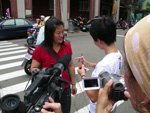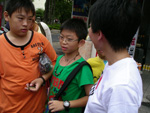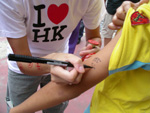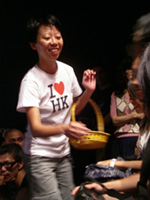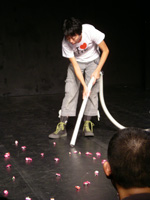Civil Left/Right.2

a media+live performance @ Taipei International Performance Art Festival
(TIPAF) 2007,
Hsinchu & Taipei, 24-30/8/2007
The second performance in the series was presented in the Taipei International Performance Art Festiva, Taiwan. The performance consisted of two parts, an outdoor performance and a theatre performance. Both parts intended to explore the issue of national identity in the social-political contexts of both Hong Kong and Taiwan. The "Taiwan Independence" has been a heated political campaign in recent years. While fighting for international recognition of the country itself, the Taiwanese government is currently campaigning a revisionist movement including removal of its first president Chiang Kai-shek's name and likeness from the airport and other public places, just like what has happened to Hong Kong in a process of decolonization. Unlike Hong Kong being unified to be part of China, however, people in Taiwan are taking off their Chinese cultural roots and establishing themselves as Taiwanese. |
Part 1 of my performance was presented in the East Gate Park, an historical site with Chinese-style architecture in the centre of Hsinchu city, Taipei. Hsinchu is a historical town on the northeast coast of Taiwan, and I was told that a lot of followers of the Nationalist party moved from mainland China to Hsinchu in Taiwan during and after the civic war in the late 1940s. Walking out from the ancient town gate to the, I greeted the passers-by by asking them to mark a Chinese character "中" (which means “centre” or the name of China) with a rubber stamp on any part of my body. "I am Chinese, and you?" I asked each of the respondents after being stamped. All of them except one replied me, without or for most of the time with great uncertainty, "I am Taiwanese." I then wrote "Taiwanese 台灣人" on the same part of their body and declared, "I am Chinese, and you are Taiwanese." Whether being cultured to be a Chinese or Taiwanese, our doubts about identity may remains even if the marks on our bodies were being washed away by sweats, water or soaps afterwards |
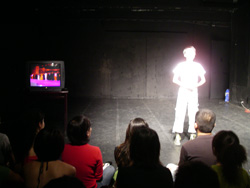 Part 2 of the performance was presented in a studio theatre.
The performance was full of cultural symbols of Taiwan, for example, playing
national anthem which was used to be a rite in cinema and theatre in Taiwan
between the 60s and 80s where people would stood up solemnly, plum blossom
the national flower, as well as songs of Teresa Teng (鄧麗君), who was named
"Singing Queen from Taiwan" and was very popular in the whole
Chinese-speaking region including mainland China during the 80s.
Part 2 of the performance was presented in a studio theatre.
The performance was full of cultural symbols of Taiwan, for example, playing
national anthem which was used to be a rite in cinema and theatre in Taiwan
between the 60s and 80s where people would stood up solemnly, plum blossom
the national flower, as well as songs of Teresa Teng (鄧麗君), who was named
"Singing Queen from Taiwan" and was very popular in the whole
Chinese-speaking region including mainland China during the 80s.
The whole performance was driven by various love songs by Teresa Teng interrupted frequently by a communist patriotic song (Praising the Motherland 歌唱祖國) which is often used in the celebration of the 10th anniversary of Hong Kong's Handover. Video was shown on the television on stage with footage of Hong Kong official celebration of the 10th anniversary of the Handover inter-cut with news footage of Taiwan's recent revisionist campaign. Surprisingly and interestingly enough, the audience was totally absorbed in my seemingly amusing yet political action. After mimicking the patriotic song in Putonghua, I tried to pick the plum blossoms from the audience but they had never resisted my action while listening to and moving with the rhythm of the sweet song by Teresa Teng. Following my "Love me, love me not" statement, I vacuumed up the flowers scattered on the floor, and again, the audience had not resisted my return of flowers to them buried in the dust and trash inside the vacuum cleaner. After all, is the so-called national identity just something imposed by the authority and can be disposable? What does it mean to be a Chinese or Taiwanese culturally, ethnically and politically? What to be kept or discarded that represent our national identity and that are connected to ourselves? The answers seem to dialectic and paradoxical... |
-
My Heart, My Comrades, My Country
熱烈慶祝 • 心繫祖國 (@Chengdu, 26/5/2007) -
De...nization
去你的 (@Taipei, 24-30/8/2007) -
Here I am
香港始終有你 (@Hong Kong, 13-14/10/2007) -
Beat or Bet
有倒未為輸 (@Macau, 20/10/2007) -
We Are Ready
起來……的人們 (@Xi'an, 13/11/2007)
